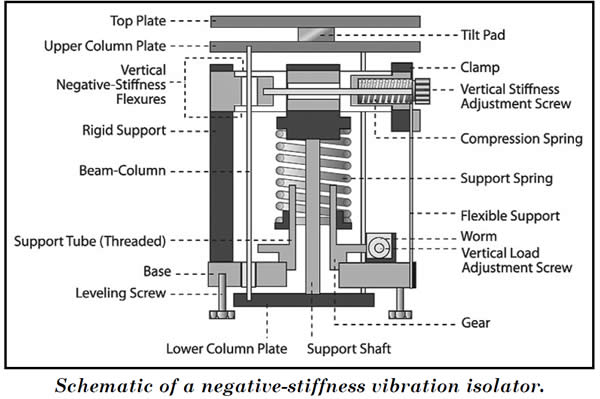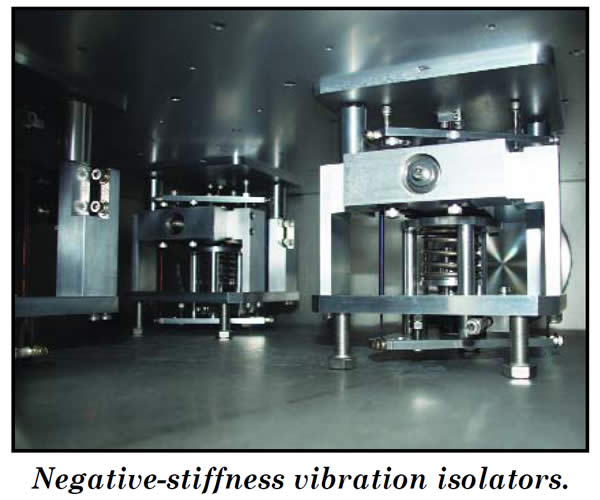
U.S. Tech – March 2023
Test and Inspection
Negative-Stiffness Vibration Isolators Support Research on Gravitational Waves
By Jim McMahon
More than 100 years ago, Albert Einstein portrayed a completely new picture of our world in his General Theory of Relativity. This theory, in contrast to Newton, postulates that gravitation is not a force, but a consequence of the geometry of space and time, and that big masses like stars and galaxies deform space-time around them.
Accelerated motion of these large masses, such as that produced by violent events in the distant universe from the collision of two black holes or by the cores of supernova explosions, creates ripples in this geometry. These ripples in the spacetime fabric propagate in all directions at the velocity of light. They are called gravitational waves, and they alternately stretch and compress space, so that the distances between the objects in space are changed.
When these gravitational waves travel to Earth, they bring with them information about their violent origins, and about the nature of gravity that cannot be obtained by other astronomical tools.
Gravitational Wave Detection
Einstein predicted the existence of gravitational waves in 1916, but only in the last 10 years has technology become powerful enough to permit detecting these waves and harnessing them for science.

The changes in distance that are caused by gravitational waves are tiny. Even the gravitational locally, like a supernova explosion within the Milky Way, changes the total distance between Earth and the Sun only by about the diameter of a hydrogen atom, and that merely for several thousandths of a second.
For longer distances the effect is correspondingly smaller. To detect and measure gravitational waves requires extremely sensitive instrumentation.
In the 1970s, American physicist Rainer Weiss pioneered the concept of using lasers for interferometric gravitational wave detection. Extensive research over the past several decades has produced extremely advanced interferometric techniques, providing a means to observe phenomena in the universe that previously could not be studied otherwise.
“With laser interferometry we can retrieve information from spaces in the universe that are otherwise not accessible, and we can look back in time much further,” says Dr. Harald Lück, research group leader for the laser interferometry and gravitational wave astronomy division of the Max Planck Institute in Gravitational Physics (alternately known as the Albert Einstein Institute) in Hannover, Germany. “The earliest we get from looking at the sky with telescopes is from about 380,000 years after the big bang. Before that everything was too hot. It’s a deep fog, known as the microwave background, and we cannot look back any further. But with gravitational waves we will be able to do so.”
The scientists of the Laser Interferometry and Gravitational Wave Astronomy division play a globally leading role in developing cutting-edge technologies for gravitational wave observatories. Many of the methods initially demonstrated at the Albert Einstein Institute are now being used in the large observatories of the LIGO and Virgo Collaborations, and have significantly increased their sensitivity.
Gravitational Wave Detector
Together with its UK colleagues, and Leibniz Universität Hannover, the Laser Interferometry and Gravitational Wave Astronomy division of the Albert Einstein Institute operates the gravitational wave detector, GEO600. Funded by the Max Planck Society, and the Science and Technology Facilities Council, GEO600 is a ground-based interferometric gravitational wave detector located near Hannover, Germany.
Scientists at GEO600 have pushed research into interferometry related technologies to their limits, encompassing laser stabilization, absorption-free optics, control engineering, vibration damping, and data acquisition and processing.
“GEO600 is also the first gravitational wave detector that uses squeezed laser light to improve sensitivity,” says Dr. Lück. “Squeezed states are of high interest since they show a squeezed uncertainty which can be used to improve the sensitivity of measurement devices beyond the usual quantum noise limits.”
“Individual photons will hit the detector at an uneven rate,” explained Lück. “Because of quantum fluctuations, these photons will show up as a fluctuating background signal that could completely obscure the expected short gravitational wave signal from the event itself.”

Shielding from Vibration
A significant challenge in gravitational wave interferometry is to get rid of disturbances like air pressure and temperature fluctuations, as well as seismic vibrations of all sorts that would conceal a signal.
The detection bench, carrying mode matching optics, a Faraday isolator, an output mode cleaner, and the photo diode are situated on a breadboard, which is sitting upon three negative-stiffness vibration isolators to isolate from ground motion. This entire assembly is enclosed within a vacuum chamber.
Specific attention was given to the selection of vibration isolators supporting the breadboard within the vacuum chamber. Seismic disturbances are particularly noticeable when making measurements in the low-frequency range below 100 Hertz. “We selected Negative-Stiffness vibration isolators because they are very simple to use, compact, and operate without the need for compressed air or electronic cabling,” explained Dr. Lück.
Negative-Stiffness vibration isolation was developed by Minus K Technology, an OEM supplier to leading manufacturers of scanning probe microscopes, micro-hardness testers and other vibration-sensitive instruments and equipment, such as for testing zero-g simulation of spacecraft.
These vibration isolators are compact, and do not require electricity or compressed air which enables sensitive instruments to be located wherever a production facility or laboratory needs to be located. There are no motors, pumps or chambers, and no maintenance because there is nothing to wear out. They operate purely in a passive mechanical mode.
What is very advantageous about Negative-Stiffness isolators is that they achieve a high level of isolation in multiple directions.
These isolators have the flexibility of custom tailoring resonant frequencies to 0.5 Hz vertically and horizontally (with some versions at 1.5 Hz horizontally). “Vertical-motion isolation is provided by a stiff spring that supports a weight load, combined with a Negative-Stiffness mechanism,” says Dr. David Platus, inventor of negative-stiffness isolators, and president and founder of Minus K Technology. “The net vertical stiffness is made very low without affecting the static load-supporting capability of the spring. Beam-columns connected in series with the vertical-motion isolator provide horizontal-motion isolation. A beam-column behaves as a spring combined with a negative-stiffness mechanism. The result is a compact passive isolator capable of very low vertical and horizontal natural frequencies and very high internal structural frequencies.”
“One issue with our systems that we use is the suppression of the resonance,” added Dr. Lück. “And here, the negative-stiffness isolators turn what is usually considered a disadvantage into an advantage. If you build a low-frequency suspension system then you typically find that the mechanical Q values go down and the dissipation goes up. I think that is what the Minus K isolators use for keeping the resonance peak low enough, and that is a very neat use of turning this seeming disadvantage into an advantage.”
Contact: Minus K Technology, Inc., 460 Hindry Avenue, Unit C, Inglewood, CA 90301, 310-348-9656 E-mail: request@minusk.com Web: www.minusk.com
|